The popular picture of Revolutionary armies shows troops camping upon a tented field. Campaigning soldiers often "lay on their arms" without any covering or built shelters from materials at hand, because of the divestment of baggage to enhance mobility, or a lack of tentage due to supply shortages.
British soldiers began using temporary campaign shelters as early as 1776, building them more often, and relying upon their shelter for longer periods, than did their Continental Army counterparts. British troops usually resorted to "wigwams," a popular appellation that probably began as a derogatory term for any type of ad hoc structure; as the war progressed wigwams (usually some form of brush hut) became customarily adopted as a useful and acceptable alternative to tents.
During the autumn 1776 campaigns around New York City a British officer of the 40th Regiment noted in his diary:
16 September 1776, "... no tents ... encamped near on ye Common."
17 September, " ... Very wet m[ornin]g. p.m. Cleared. No tents, built wigwams ..."
18 September, "... got our Tents."1
The following year saw increasing British recourse to makeshift shelters. Initially the army's light troops predominantly used them. British 52nd Regiment officer Martin Hunter noted that in spring and summer 1777 "The Light Infantry were always in front of the army, and not allowed tents. We generally quartered our men in farmhouses and barns, or made huts when houses were not conveniently situated ..." Eventually all units constructed makeshift shelters as an occasional alternative to tents in the field. Timothy Pickering described how, "On the 19th [June 1777], General Howe decamped with the greatest precipitation from Millstone [New Jersey], and retired to Brunswick ... That part of his army which had advanced to Middle Bush and Millstone had no tents, but lodged in booths." Corporal Thomas Sullivan, 49th Regiment, wrote that on June 28th, his unit marched "to Amboy, and took up our former encampment, where we built Wigwams, for we had no tents." On 7 August American Ebenezer Hazard noted the "Great Devastation ... made by the Enemy at Somerset Court House" including "Thatch ... torn off of Barns & Barracks, & two Orchards ... cut down that Booths might be made for the Soldiers, of the Branches of the Trees. The Enemy's advanced Guard was kept in an Orchard just back of the Court House; their main Body laid about half a Mile farther on a beautiful rising Ground: their Booths still remain there."2
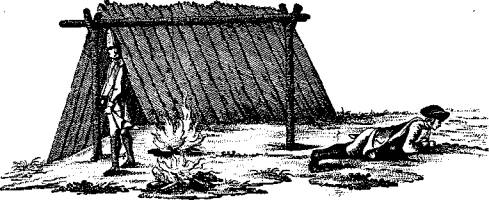
FIG 20. Wooden tent pictured in the German military manual Was ist jedem Officier waehrend, 1788). Courtesy of Charles Beale.
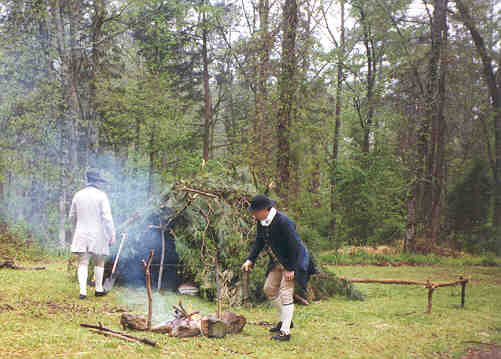
FIG 21. Brush hut built using "cratchet" supports. (Photograph by John Rees, North Carolina Volunteers, Historic Stagville, April 1997.)
During the Philadelphia campaign, lasting from late August to December 1777, wigwams almost entirely replaced tents as shelter. General George Washington's 7 September orders mentioned "the Intilligence ... that the Enemy has Disencumber'd themselves of all their Baggage even tents Reserving only their Blankets, & Such part of their Clothing as is Absolutely Necessary, this Indicates A Speedy and Rapid movement"; he then required that his own troops do the same. Major Carl Leopold Baurmeister, a Hessian staff officer with General Sir William Howe's army, confirmed this, noting that the British "army remained encamped through the 7th of September, during which time all tents and other heavy baggage and the sick were taken to Elk Town and put on transports, so that the provision train could be strengthened ..." Lieutenant William Hale, 45th Regiment Grenadier Company, later recalled how this effected the soldiers: "The fatigues of the march from the Head of the Elk River to Philadelphia ... were really great, our best habitations being wigwams, through which the heavy rains of this climate ... easily penetrated."3
Soon after disembarking from transports the troops were living in brush shelters. Lieutenant Hale wrote from Head of Elk on 30 August, "We passed three most uncomfortable nights in Wigwams, drenched to the skin by those torrents of rain common in this Southern climate ... we are now encamped, or more properly speaking enwigwamed, on the other side of the Town ..." He then noted his own circumstances. "By good fortune my canteen was brought this morning, for this week past we have lived like beasts, no plates, no dishes, no tableclothes, biscuits supply the place of the first but for the others no substitute can be found ... I write this under a tree, while my black is making a fire to boil my pork, and my white servant is pitching my tent."4
Brush huts were mentioned in several orders for the 2nd Battalion of Light Infantry in the weeks before the Battle of Germantown.
Bat[talio]n orders [19 September 1777] ... Commanding officers of Companys will not Alow their Men upon any Pretence wath [sic] ever to quit their Arms, Except to make Wigwarms, without his Leave untill the Picquetts are Posted.
B.O. [26 September 1777, Germantown] The Companies [are] to make Wigwams as fast as possible, the Q[uarter]M[aste]r. Will attend & show [them] their Ground.5
Martin Hunter recounted that the advanced light infantry "had changed our quarters two days before [the battle] from the houses in Beggarstown to wigwams outside the town ..." At the onset of the Continental Army's Germantown attack "the battalion was out and under arms in a minute; so much had they in recollection Wayne's affair [i.e., the Battle at Paoli] that many of them rushed out at the back part of the huts." Another British officer wrote, "Octr 4th This morning at 6 O'Clock, we were attack'd at several different Quarters by ye Rebel Army... The 1st battln of Light Infantry was entirely Surrounded, their Wigwams, & provision Waggon in possession of the Enemy, 'till they fought their way thro' and retook them."6
While most of Howe's army took up quarters in and around Philadelphia after the Germantown battle, a large force under Lord Cornwallis was sent into New Jersey. Captain William Haslewood, 63rd Regiment, described the detachment's activities and the shelters used:
The 18th. Novemr [1777] the 63d with many other Regiments landed at Billins Port [New Jersey] ... on the 22d the Army march'd to five Mile Bridge ... Remaind one night Here in Wigwams and during our stay Collected 300 Head of fat Cattle and 1000 Sheep [On the] 23d We march'd to Newberry to join Ld Cornwallis, immediately on our arrival the 63d was order'd to red Bank a strong Reboubt the Rebels had abandoned the proceeding Night. The 26th., 33d, 63d and a Company of Guards remained here three nights in Wigwams and demolish'd the Works ...7
After the year's campaigning seemed at an end one final sortie was made by the British occupying Philadelphia. Stemming from the need to gather food and forage to tide his troops over for the winter months, Sir William Howe sent most of his army into the Pennsylvania countryside south of the city. Captain Haslewood noted, "20th. Decem [1777] a large [part of the British] Army crosses over the [Schuylkill Bridge] ... and advances 7 or 8 Miles Into the Country remains there for a Fortnigh[t] In Wigwams ... great quantity of Forrage and Cattle were taken ..."8 German Captain Friedrich von Muenchhausen echoed this account:
[22 December 1777] In the morning General Howe marched with ... 8,000 men in one column across the Schuylkill over the pontoon bridge which was constructed yesterday. With these troops he formed one line extending from the other side of this bridge to beyond Darby, seven miles from here, where our left wing deployed so as to cover the flank. About 500 wagons, which we had taken along, at once began foraging behind the line. Our men constructed temporary cover as well as they could. We did not have tents with us, as we almost never did during this whole campaign.9
The next widespread use of wigwams and huts by British forces occurred during the Monmouth Campaign in June 1778. After General Sir Henry Clinton's forces completed the evacuation of Philadelphia, Captain John Peebles, 42nd Regiment, noted, "Thursday [June] 18th [1778] ... the Troops march'd to within 2 miles of Haddonfield where they Encampd in the usual manner, vizt. Wigwams ..."10 German Lieutenant John Charles Philip von Krafft left a detailed account of shelters used during the march across New Jersey:
[15 June 1778] It may have been 7.30 P.M. when we arrived there [at a place two and a half miles past Coopers Ferry]. As we had no tents and it was too late to build huts, I lay down under a tree to sleep.
[16 June] In the morning order was given to erect huts, because we were to remain here until all had overtaken us from Philadelphia.
[18 June] ... we passed through the little town of Hottenfelt [Haddonfield], where, at about 8 o'clock, we who were on the extreme right camped under huts on a fallow field.
[20 June] At 3 A.M. we marched away again ... during a heavy rain. Towards noon we built huts in a meadow near the town of Morristown [Moorestown] ...
[21 June] From 3 in the morning until noon I had the rear guard of our and the English regiment, again in the heavy rain. In the afternoon we marched during the terrific heat ... Our Grenadiers and the English, which were in front got into camp about 6.30 P.M., on the right in front of the town [of Mount Holly], in bush [huts], again in the wheat ... This night there was a terrific thunderstorm and the rain poured down so hard that we in our bush-huts got very wet.
[22 June] About noon we again pitched our hut-camp on a meadow at Black Horse [Tavern] ...
[23 June] At 4 A.M. we moved again, in the middle of the army, till towards evening when we again pitched our camp in a fallow field at Racklestown [Recklesstown] ... [After leaving the encampment for a short time] we hastened toward our camp and [met] ... in the woods that extend nearly up to our huts, some soldiers of our Company who were in search of wood ...
[25 June] At 7 in the evening we reached ... Frehold Township ... and pitched our tents on a fallow field.
[26 June] At noon we ... were near the little town of Freholdt ... at a short distance away from the place ... we pitched our camp in a fallow field ... That evening there was a terrific thunderstorm ... I lay in my hut, on account of the rain, leaning on my left arm, together with my orderly, when there was a fearful thunderclap, so that I could not help thinking my hut had been struck. But it struck at a distance of only 15 paces behind my hut ...
[28 June] At 8.45 P.M. we camped at Notchwarb, in the midst of woods and on an elevation in a field of beautiful wheat. We postponed building our huts until the next day on account of our fatigue.
[30 June] At 7 A.M. we broke up our camp and marched through the borough of Mittletown ... until we reached, two miles further on, quite a large hill where we pitched our camp ... Huts were built, but owing to the heat, it was almost impossible to breath underneath them.11
Crown forces used wigwams only intermittently over the next year and a half, and then only by small detachments sent out occasionally. German private Johann Conrad Doehla of the Bayreuth Regiment described one such instance in June 1780: "We camped there [Philips' Point, New York]. Because of a shortage of tents, which were still in New York, and the great heat, we built huts for ourselves from branches with leaves."12
Beginning in 1779 the main British war effort shifted southward, but brush shelters did not play a significant role until the following year. In summer 1780 South Carolina militia colonel Richard Winn noted brush huts being used by a mixed contingent of British regulars and provincial troops; he wrote that at the Battle of Hanging Rock, on 6 August, American forces attacked "the British camp which we found in an open old field ... The British immediately commenced firing from behind some bush tents." Later that same month, after the destruction of General Horatio Gates' army at Camden, South Carolina, on 16 August, Lord Cornwallis determined to move into North Carolina. On 1 October General Jethro Sumner informed Gates, "Colonel Dickerson, who was on the Enemy's Lines yesterday ... discovered 800 of them upon their march, three miles in advance from Charlotte ... on the Road leading to Bety's ford on Catawba River, about 9 o'clock in the morning ... it was given out they were to march in ten Days from Newbern; that they were building brush Hutts, their Lines were circumscribed close in the Town ..." This report was repeated in the Virginia Gazette, "Richmond, October 11. Our latest advices from the southward are ... that on the 26th, [September] the enemy, from 2 to 3000 strong, advanced to Charlotte....They brought with them to Charlotte, about 80 waggons, and 70 or 80 hogsheads of rum; they were building brush huts; their lines were circumscribed close in the town, and the roll called very often in the day; their liquors were stored."13
Operations continued through that winter, and after the Battle of Guilford Courthouse in March 1781 the British troops divested themselves of all excess baggage, including tents. A private in the 33rd Regiment, campaigning with Cornwallis in North Carolina during 1780-81, matter-of-factly noted in an anecdote, "one day, when myself and several of my companions had made a fire before our wigwam ..." In the midst of operations in Virginia, an observer described a typical British camp of the period: “June 8. [1781] On the 5th the Enemy [i.e., Earl Cornwallis’s army] decamped from Mrs. Nicholas’s & took the road leading to Goochland Court House [Virginia] … The day after the Enemy left Mrs. Nicholas’s I went over to her house where I saw the devastation caused by the Enemy’s encamping there … all round the house. The fences pulled down & much of them burnt; Many cattle, hogs, sheep & poultry of all sorts killed; 150 barrels of corn eat up or wasted; & the offal of the cattle &c. with dead horses & pieces of flesh all in a putrefying state scattered over the plantation … There was not one Tent in the British army, all of them lying under temporary sheds or arbours, made with the boughs of Trees, fence rails &c. even officers of the highest rank, for … only Lord Cornwallis & his aids staid in the House.” And an officer with the 76th Regiment later recalled of Cornwallis's 1781 Virginia campaign, "Our encampments were always chosen on the banks of a stream, and were extremely picturesque, as we had no tents, and were obliged to construct wigwams of fresh boughs to keep off the rays of the sun during the day."14 Regimental orders for the 43rd Foot confirm the use of brush shelters that summer.
[30 June 1781, Williamsburg, Virginia] The Officers Commanding Companies [are] to see [that] the Wig Wams [are] made as secure against Sun and Rain as possible.
[11 August] It is the Majors positive Order that the Soldiers of the Regiment shall sleep in either their tents or Wigwams.
[27 August, Yorktown] Commanding Officers of Companies will inspect the Mens Wigwams and report whether they are proper or not.
[9 September] The Major recomends it to the Soldiers to be in their Wigwams if Water-tight in preference to the tents.
[27 September] The Regt will leave the Wigwams Standing.15
On Gloucester Point, across the York River, German Captain Johann Ewald mentioned his shelter on 18 September: “Since the day before yesterday the southern land fever has suddenly attacked me from ten until two o’clock daily, whereby I suffered extremely from the terrible heat in my brush hut.” 16
At the end of September American surgeon James Thatcher noted, "We were agreeably surprised this morning, to find that the enemy had, during the preceding night, abandoned three or four of their redoubts, and retired within the town [Yorktown], leaving a considerable extent of commanding ground, which might have cost us much labor and many lives to obtain by force.
" Early in October he mentioned one of the abandoned British huts. "A large detachment of the allied army, under command of Major-General Lincoln, were ordered out last evening for the purpose of opening intrenchments near the enemy's lines ... we were favored ... with a night of extreme darkness ... In the latter part of the night it rained severely, and being in the open field, cold and uncomfortable, I entered a small hut made of brush, which the enemy had abandoned. Soon after, a man came to the door, and seeing me standing in the centre, instantly drew his sword ... I called out friend, friend, and he as speedily, to my great joy, responded, 'Ah, Monsieur, friend ..."17
With the surrender of Yorktown, large-scale field operations came to an end. Brush huts continued to be used by both sides in the ensuing months but never again in the numbers seen earlier in the war.
"Laying
up poles and covering them with leaves ..."
Building
Brush Huts
The first step in reconstructing a wigwam is to ascertain how soldiers' built them. Unfortunately, there are only a few illustrations or detailed descriptions to guide us. The best-documented design consists of a long ridgepole supported by two upright forked tree limbs driven into the ground. Seventeenth-century English carpenters knew these supports as "Cratchets" or "crotchets." The "English crutch" is a variation on this design. In that method the ridgepole is placed on two sets of crossed poles tied together at the top to form supports. When using this form one end of the hut needs to be secured to an upright driven into the ground; it is possible that huts built this way were secured to a still-standing tree. (Several tent-shaped booths pictured in an original print of the Thames Frost Fair, circa 1739, were built with the "English crutch" method.) Simple open-faced lean-tos or wedge-shaped shelters can both be built using these methods. Continental soldiers are known to have used the cratchet form of construction. An American officer near Valley Forge in December 1777 lodged in a brush hut "made with two forked saplings, placed in the ground, another [sapling] from one to the other. Against this, fence-rails were placed, sloping, on which leaves and snow were thrown, and thus made comfortable." This method was also used for a wooden tent pictured in the 1788 German military manual, Was ist jedem Officier waehrend eines Feldzugs zu wissen noethig ("What it is necessary for each officer to know during a campaign").18
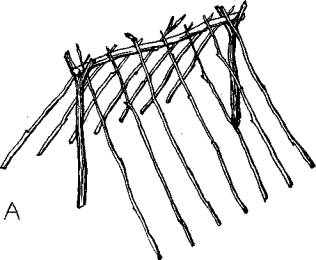
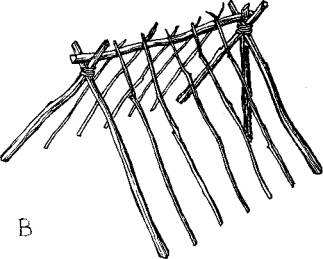
FIG 22. Another form of brush hut. Figure A. shows a long ridge pole supported by two upright forked sticks (called "Cratchets" or "crotchets"), driven into the ground; in figure B. the ridge pole is placed on two crossed poles tied together at the top to form a support (an "English crutch"). When using this last method one end needs to be secured to an upright driven into the ground. Either a simple lean-to or a wedge-shaped shelter can be built with these methods. (Illustrations by Ross Hamel.)
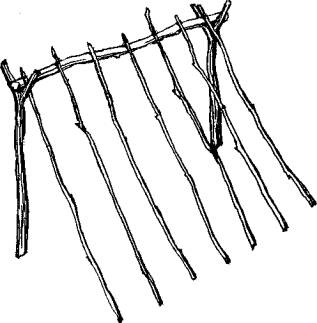
FIG 23. Sheds and brush huts were also built in the form of an open-faced half-shelter. A structure of this type, covered over with branches and leaves, was built by soldiers in December 1777. Some bowers constructed by Lafayette's troops in summer 1781 may have looked like this. (Illustration by Ross Hamel)
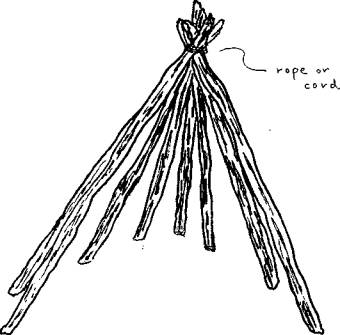
FIG 24. The basic structure of a cone-shaped wigwam or brush hut before the outer covering is added. (Illustration by John Rees.)
Another wigwam type was cone-shaped, similar to huts built by early English colonists in America and those used as dwellings by goatherds, shepherds, and fieldworkers in England for hundreds of years prior the eighteenth century. They also resembled conical living quarters built by charcoal burners and bark-peelers, probably also predating the eighteenth century. The American brush huts shown in the 1782 painting "The Battle of Paoli," by Xavier della Gatta, look to be A-frame in form, but because of the crude way they were drawn can also be interpreted as conical structures. (For details from the Paoli painting see Stephen R. Gilbert, "An Analysis of the Xavier della Gatta Paintings of the Battles of Paoli and Germantown, 1777: Part I," MC&H, XLVI, 3 (Fall 1994), 98, 106.) There are no accounts describing the construction of cone-shaped wigwams, but the form was well-known and simple to build. American Surgeon James Thacher may have alluded to conical wigwams with a low entrance and enough headroom to stand upright in the center when he referred to the abandoned British dwellings outside Yorktown: "I entered a small hut made of brush, which the enemy had abandoned. Soon after, a man came to the door, and seeing me standing in the centre, instantly drew his sword ..."19
The basic structure of a conical wigwam consists of three tree limbs or saplings (from eight to twelve feet long) tied together at their tops and then set up; to ensure they remain in place the bottoms of the poles can be dug slightly into the ground. More poles can then be added, and leaf-covered branches or pine boughs placed over the completed frame.
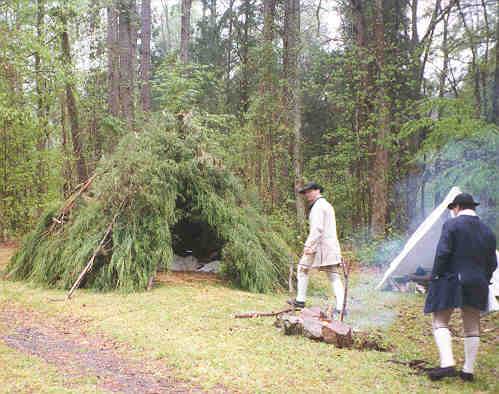
FIG 25. One type of brush hut (wigwam) constructed by British and Continental soldiers. After erecting a tripod of long poles (tied together at the top), additional poles are added to fill in the structure, and leaf-covered branches or pine boughs placed over them as a covering. (Photograph by John Rees, North Carolina Volunteers, Historic Stagville, April 1997.)
Structures similar to conical brush huts were recommended to cover camp kitchens in cold weather. In his 1768 System for the Compleat Interior Management and Oeconomy of a Battalion of Infantry, Bennett Cuthbertson noted, when "a Regiment is to remain very late in the Field ... [it] will require many ... precautions to make the Soldiers comfortable ... in particular during the time of cooking, when the inclemency of the weather often renders it almost impracticable, in the open air; to obviate ... [their] distress ... young trees should be collected, about the size and length of hop-poles, and placed in a circular form round the out-side of the Kitchens, sloping upwards to a point, exactly in the same position, the poles are fixed ... leaving a sufficient opening on one side, for the men to enter, and weaving small boughs or rushes through the poles: the Kitchens being defended in this manner, the Soldiers remain no longer exposed to the inconveniences of the weather; and are enabled, not only to dress their victuals, without the smallest interruption, but by making a large fire in the center of the Kitchen, to enjoy themselves in great comfort and satisfaction ..." Cuthbertson also stated that "the allied Army in Germany last war [i.e., the Seven Years' War]" used "Kitchens of this construction." The kitchens referred to were circular, earthen constructs, dug into the ground; Humphrey Bland's 1762 Treatise of Military Discipline gives twenty-nine feet as their "outer diameter."20
Among the many Continental soldiers who mentioned makeshift shelter, two left particularly interesting references. Joseph Plumb Martin's description is curious; he wrote of the Whitemarsh encampment in Pennsylvania, "we joined the grand army near Philadelphia, and the heavy baggage being sent back to the rear of the army, we were obliged to put us up huts by laying up poles and covering them with leaves, a capital shelter from winter storms." "Laying up poles" could refer to fashioning a tripod for a conical hut, or merely leaning cut limbs against a standing tree to form a crude shelter. Ensign John Markland, 6th Pennsylvania Regiment, tells of another form of makeshift shelter his soldiers built: "... from the Battle of Brandywine until their encampment near Skippack, they were constantly engaged in heavy, rapid, and severe marches, without tents or baggage. These articles having been sent far into the rear, their shelter at night being frequently nothing more then a few rails placed slantwise against a fence, with a few dry leaves, if they could be procured." Similar shelters were built by American Civil War soldiers.21
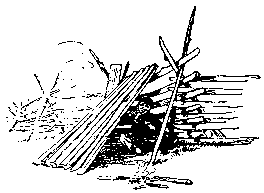
FIG 26. A Civil War fence rail shelter similar to the ones described by Ensign John Markland as being built by Continental soldiers in autumn 1777. John D. Billings, Hard Tack and Coffee (Boston, George M. Smith & Co., 1887), 142.
It is noteworthy that only British soldiers used the term "wigwam" to denote brush huts. To date I have found only one American account of soldiers' shelter, among scores, which contains the word, and that as a derogatory reference to the winter log huts at Valley Forge. Wigwam originates from several Native American variations: Ojibwa, wigwaum, wigiwam; Algonquin, weekuwom, wikiwam; Delaware, wiquoam; all literally mean their house, my house, or his house. The term was used very early by English colonists in America; one of the first settlers of Massachusetts Bay, Edward Johnson, wrote that his compatriots "burrow themselves in the Earth for their first shelter under some Hill side, casting the Earth aloft upon Timber ... in these poor Wigwames (they sing Psalms pray, and praise their God) till they can provide them houses." In 1631 Massachusetts Bay Lieutenant‑Governor Dudley noted "some English wigwams ... have taken fire in the roofs covered with thatch or boughs." For some reason the word was not generally used by American soldiers, but was retained by, and popular in, the British army during the war.22
Comparative
Use of Makeshift Shelters in
the
French and Indian War, and American Civil War
All these constructs had historical antecedents; this is evidenced by a 17th century illustration of a European army's camp showing a cluster of makeshift huts at one corner, all reminiscent of shelters used by soldiers in North America. American soldier-built board or brush shelters predated the Revolution, and Continental soldiers' military descendants used very much the same constructs during the Civil War, eighty years later.23
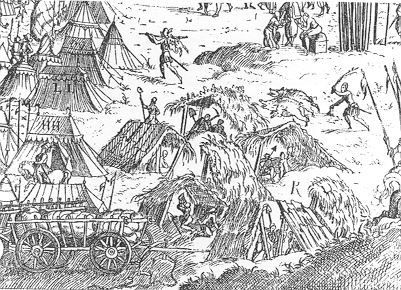
FIG 27. Makeshift huts used by European armies, circa 1550-1650. Note their similarity to shelters built by soldiers in America from the 1750's to the 1860's. Parker, European Soldiers 1550-1650, 29.
Gary S. Zaboly, in his work "A Lodging for the Night: A Brief Study of Some Types of Wilderness Shelters Used During the French and Indian War," described many different types of covering, noting that "references to brush shelters, bush tents and brush tents abound in diaries" from that conflict. Among the shelters built by British and Provincial troops were familiar A-frame constructs, open-faced half-shelters, and conical wigwams. Chaplain Robert Treat wrote of provincial soldiers' huts at Lake George in late 1755, "Their lodging is various, some using an artificial couch and others preferring the feathers the land produces, so that truly it may be said of some that their houses are fir and their bed is green."24
Federal and Confederate soldiers sometimes constructed makeshift coverings when campaigning, and a number of men described or alluded to brush, plank, and other shelters. Temporary huts were commonly used by soldiers on picket duty, and several drawings or paintings picture them, notably Edwin Forbes' "The Picket Line," "A Christmas Dinner," and "Coming into the Lines," as well as Albert Bierstadt's "Attack on a Picket Post" (1862). Forbes' huts are all freestanding lean-tos or A-frames, while Bierstadt's rendering shows a structure made of brush-covered poles leaning against a large tree. A photograph of a Federal picket at Lewinsville, Virginia, clearly shows a six foot high half-shelter built by the men; Wilbur Hinman, Civil War veteran and author, pictured such a half-shelter in his work Corporal Si Klegg and his "Pard". The only pictorial southern example I have found is in a sketch by Conrad Chapman of a Confederate soldier on picket duty. In the background is a half-shelter or lean-to of poles or fence rails.25
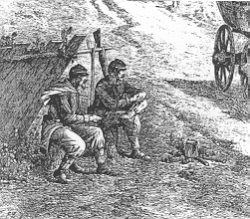
FIG 28. "... outpost guards ... heating a pot of morning coffee ..."; detail of Edwin Forbes' "Coming into the Lines." Dawson, A Civil War Artist at the Front, plate 38.
Occasionally makeshift shelters were found in large, settled camps. Winslow Homer's "Playing Old Soldier" (1865) shows a brush lean-to which seems be a surgeon's hut, while Sanford Robinson Gifford's painting "The Evening Meal of the Seventh Regiment New York in Camp near Frederick, Maryland, 1863" (1864), portrays an encampment consisting of two large Sibley tents surrounded by at least twenty straw-covered shelters, whose basic structures are probably comprised of boards or fence rails. Most are simple open-faced lean-tos of various sizes, although several A-frame structures can also be seen (see accompanying illustrations). The shelters pictured by Gifford resemble straw huts photographed after the battle at Sharpsburg, Maryland, in 1862.26
Such Civil War shelters were variously described as shanties, "houses of boughs and blankets," and "shelters of boughs"; they were also commonly called "shebangs" or "booths." The term "shebang" is hard to pin down; defined by the Oxford English Dictionary as U.S. slang, "A hut, shed; one's dwelling, quarters," in the eastern armies it seems to have meant a brush hut, half-shelter or any other hastily constructed campaign covering. In the west a shebang was usually, though not always, more substantial, and was often applied to plank shacks and winter huts. While visiting troops at Falmouth, Virginia, in late December 1862 poet Walt Whitman saw them "Sometimes at night ... around the fires, in their shebang enclosures of bushes." In January 1863 on his route home from Falmouth, Whitman encountered "soldiers guarding the [rail]road [who] came out from their tents or shebangs of bushes with rumpled hair and half-awake look." Second Lieutenant Eugene Carter, 3rd U.S. Infantry, noted during the movement towards Manassas, Virginia, in July 1861, that the day was "extremely warm ... [and] our men built booths of bushes for us, which were very comfortable." Booths or shades were also seen after the Battle of Cedar Mountain (9 August 1862) when the wounded of both armies were left on the field in the hands of Confederate forces. Although largely preoccupied with their own men, southern troops were able to afford at least some care to their suffering enemies. One Federal officer, visiting the battlefield soon after, found northern casualties "lying under booths of gum branches, each man with a canteen of water by his side." Another northern soldier wrote that "some humane Confederates had brought water, and built shelters of boughs to protect a few of the wounded from the hot sun." Booths made from poles and blankets or tent cloth were photographed sheltering Confederate wounded near Sharpsburg in 1862.27 (For more on Civil War lodgings see, John U. Rees, "'Shebangs,' 'Shades,' and Shelter Tents: An Overview of Civil War Soldiers' Campaign Shelters" two parts, Muzzleloader, vol. XXX, no. 1 (March/April 2003), 69-75; vol. XXX, no. 2 (May/June 2003), 63-69.)
In the final installments of this series we will examine Continental soldiers' use of booths and brush huts.
Acknowledgments
Many thanks to Charles Beale, Kevin Coyle, Company Member Steve Gilbert, Justin Grabowski, Kurt Hague, Don N. Hagist, Ross Hamel, Chris Hughes, Garry W. Stone, Mark Turdo, Tim Wilson, and Fellow Marko Zlatich for contributions of information or help with brush hut and bower reconstruction. I also owe appreciation to Historic Stagville, Monmouth Battlefield State Park, the Friends of Monmouth Battlefield, Yorktown Victory Center, Helms' Company, 2nd New Jersey Regiment, and the King's Own Patriots (North Carolina Volunteers) for their assistance and support. As always the David Library of the American Revolution, with their extensive collection, was an invaluable resource. Finally, this work would would not have been possible without my good friend Charles LeCount who contributed material on 17th and 18th century building techniques, Native American structures, as well as other research, and provided much-needed advice and encouragement.
Endnotes
1."Bamford's Diary: The Revolutionary Diary of a British Officer," Maryland Historical Magazine, 27 (Sept. 1932), 9.
2. Martin Hunter, The Journal of Gen. Sir Martin Hunter (Edinburgh, The Edinburgh Press, 1894), 27 (hereafter cited as Martin Hunter, Journal). Octavius Pickering, The Life of Timothy Pickering, I (Boston, Little, Brown & Co., 1867), 142. Joseph Lee Boyle, From Redcoat to Rebel: The Thomas Sullivan Journal (Bowie Maryland, Heritage Books, Inc., 1997), 122 (49th Regiment). "Ebenezer Hazard's Diary: New Jersey During the Revolution," New Jersey History XC, no. 3 (whole no. 350) (Autumn 1972), 173.
3. Joseph Brown Turner, ed., The Journal and Order Book of Captain Robert Kirkwood of the Delaware Regiment of the Continental Line (Port Washington, N.Y., and London, Kennikat Press, 1970), 165-166. Bernard Uhlendorf, translator and annotater, Revolution in America, Confidential Letters and Journals 1776-1784 of Adjutant General Major Baurmeister of the Hessian Forces (New Brunswick, N.J., Rutgers Univ. Press, 1957), 103. William Hale letter, 23 March 1778, Walter Harold Wilkin, Some British Soldiers in America (London, Hugh Rees, Ltd., 1914), 246.
4. Ibid., 227-229.
5. Orderly Book of Captain Thomas Armstrong's Company of the 64th Regiment of Foot (2nd Battalion British Light Infantry), 14 September 1777 to 30 October 1777, George Washington Papers, Library of Congress, Presidential Papers Microfilm, (Washington, DC, 1961), series 6B, vol. 3.
6. Martin Hunter, Journal, 33. Henry Stirke, lieutenant, Light Company, 10th Regiment, "A British Officer's Revolutionary War Journal, 1776‑1778", Maryland Historical Magazine, 56 (1961), 172.
7. William Haslewood, captain 63rd Regiment, "Journal of a British Officer During the American Revolution", Mississippi Valley Historical Review, 7 (1920), 58.
8. Ibid., 58.
9. Ernst Kipping and Samuel Stelle Smith, At General Howe's Side, 1776-1778 (Monmouth Beach, N.J., Philip Freneau Press, 1974), 46.
10. John Peebles Journals (microfilm edition), Scottish Record Office, Edinburgh. Cunninghame of Thorntoun Papers (GD 21); Papers of Lt., later Capt., John Peebles of the 42d. Foot. 1776‑1782; incl. 13 notebooks comprising his journal; book #6, 1778 Monmouth Campaign.
11. "Journal of Lieutenant John Charles Philip von Krafft, of the Regiment Von Bose, 1776-1784," Collections of the New-York Historical Society for the Year 1882 (New York, New-York Historical Society, 1883), 40-49.
12. Bruce E. Burgoyne, trans/ed., Johann Conrad Doehla, A Hessian Diary of the American Revolution (Norman, Ok, and London, Univ. of Oklahoma Press, 1990), 133.
13. Samuel C. Williams, ed., "General Richard Winn's Notes - 1780," South Carolina Historical & Geneaological Magazine, XLIII (1942), 211. Walter Clark, ed., The State Records of North Carolina, XV, 1780-1781 (Wilmington, N.C., Broadfoot Publishing Co., 1993), 90-91. The Virginia Gazette, Dixon & Nicholson, No. 84, 11 October 1780.
14. John Robert Shaw, A Narrative of the Life & Travels of John Robert Shaw, the Well-Digger, Now Resident in Lexington, Kentucky, Daniel Bradford, 1807 (reprint edition, Louisville, Ky., 1930), 58. Richard K. MacMaster, ed., “News of the Yorktown Campaign: The Journal of Dr. Robert Honeyman, April 17-November 25, 1781,” The Virginia Magazine of History and Biography, vol. 79, no. 2 (October 1971), 401-402. Samuel Graham, "An English Officer's Account of his Services in America ‑ 1779‑1781. Memoirs of Lt.‑General Samuel Graham," Historical Magazine (1865), 269.
15. British Orderly Book, H.B.M. 43rd Regiment of Foot, 23 May to 25 August 1781, British Museum, London, MSS 42,449.
16. Captain Johann Ewald, Diary of the American War: A Hessian Journal, Joseph P. Tustin, editor and translator [New Haven, Ct., 1979] 328.
17. James Thacher, Military Journal of the American Revolution (Hartford, Ct., Hurlbut, Williams & Co., American Subscription Publishing House, 1862), 279-280 (hereafter cited as Thacher, Military Journal).
18. Discussion of "characteristic elements of primitive house construction in England," Fiske Kimball, Domestic Architecture of the American Colonies and of the Early Republic (New York, Charles Scribner's Sons, 1922), 3‑6 (hereafter cited as Kimball, Domestic Architecture of the American Colonies). Keith West, The Book of the Fair 1700‑1825, 16. "The Papers of General Samuel Smith. The General's Autobiography", The Historical Magazine, VII, 2nd series, no. 2 (February 1870), 91. Wooden tent, from a German military manual. Was ist jedem Officier waehrend eines Feldzugs zu wissen noethig (trans., "What it is necessary for each officer to know during a campaign") (Carlsruhe, 1788) Mit zehen Kupferplatten (trans. "with ten copper plates"), Courtesy of Charles Beale.)
19. Architectural historian Fiske Kimball, writing in 1922, noted that "The simplest of the primitive dwellings of the colonists were conical huts of branches, rushes, and turf ... Such conical huts were employed in England ... by goatherds and shepherds, as well as by agricultural laborers during harvest, and are still in wide‑spread use there by charcoal burners." Kimball, Domestic Architecture of the American Colonies, 3‑6, charcoal burner's hut, 4; bark-peeler's hut (circa 1901), 5. H.L. Edlin, Woodland Crafts in Britain (London, New York, Toronto, Sydney, B.T. Batsford, Ltd., 1949), charcoal burner's hut (circa 1940), 161. Xavier della Gatta, "The Battle of Paoli" (1782), William P. Cumming and Hugh F. Rankin, The Fate of a Nation: The American Revolution through contemporary eyes (New York and London, Phaidon Press, Ltd., 1975), 177. Thacher, Military Journal, 280.
20. Bennett Cuthbertson, System for the Compleat Interior Management and Oeconomy of a Battalion of Infantry (Dublin, Boulton Grierson, Printer, 1768), 40-41. Dimensions of an earthen kitchen: "... the inner diameter [of each earthen kitchen] is sixteen feet; the breadth of the trench surrounding them, is three feet; the seat is one foot and a half; and the breadth of the outside wall two feet; which makes the outer diameter twenty‑nine feet ... The circles which are drawn in the plan [of a camp] between the grand and petty sutlers, are marked for kitchens, or places where the private men are to dress their victuals ...," Humphrey Bland, Treatise of Military Discipline (London, printed for Baldwin, Richardson, Longman, Crowder and Co., and H. Woodgate, Pater Noster-Row, 1762), 288‑290. For more on excavated kitchens see, John U. Rees, "`As many fireplaces as you have tents ...': Earthen Camp Kitchens," and "Matt and I Dig a Kitchen: Recreating an 18th-Century Cooking Excavation," Food History News, IX, 2 (Fall 1997) and 3 (Winter 1998).)
21. Joseph Plumb Martin, Private Yankee Doodle - A Narrative of Some of the Adventures, Dangers and Sufferings of a Revolutionary Soldier (Boston and Toronto, Little, Brown & Co., 1962), 98. John Markland, "The Revolutionary Services of John Markland", The Pennsylvania Magazine of History and Biography, 9 (Winter 1885), 106.
22. In January 1778 a New Jersey officer, describing the cantonment at Valley Forge, was resigned that he and his fellows would have to "give up our Notions of Jersey & Content ourselves in these Wigwams this Winter ..." William Gifford, captain 3rd New Jersey Regiment, to Benjamin Holme, Camp at Valley Forge, 12 January 1778, Revolutionary War Documents, New Jersey Historical Society. Kimball, Domestic Architecture of the American Colonies, 3‑6. The Compact Edition of the Oxford English Dictionary (Glasgow, New York, and Toronto, Oxford Univ. Press, 1971), 3776 (hereafter cited as OED). For Indian houses and wigwams see: Dell Upton, ed., America's Architectural Roots: Ethnic Groups that Built America (Natl. Trust for Historic Preservation, 1986), Algonkian village, Chippewa house with "wigwam frame" and Iroquois longhouse, 17, 19; Edgar de N. Mayhew and Minor Myers, Jr., A Documentary History of American Interiors From the Colonial Era to 1915 (New York, Charles Scribner's Sons, 1980), "Phoebe and Elizabeth Moheegan's Wigwam, Niantic, Connecticut, October 26, 1761, 75; and description of Indian wigwam, North Carolina, 1700, John Lawson ("Gent. Surveyor-General of North-Carolina"), A New Voyage to Carolina; Containing the Exact Description and Natural History of that Country: Together with the Present State thereof. And a Journal of a Thousand Miles, Travel'd thro' several Nations of Indians, Hugh Talmage Lefler, ed. (Chapel Hill, Univ. of North Carolina Press, 1967), 181-182.
23. Illustration of makeshift huts used by European armies, circa 1550-1650, Geoffrey and Angela Parker, European Soldiers 1550-1650 (Cambridge, London, New York, Melbourne, Cambridge Univ. Press, N.D.), 29 (hereafter cited as Parker, European Soldiers 1550-1650).
24. Gary S. Zaboly, "A Lodging for the Night: A Brief Study of Some Types of Wilderness Shelters Used During the French and Indian War", Muzzleloader, March/April 1989, 47-51. Fred Anderson, A Peoples Army ‑ Massachusetts Soldiers and Society in the Seven Years' War (Chapel Hill and London, Univ. of North Carolina Press, 1984), 92-93.
25. William Forrest Dawson, ed., A Civil War Artist at the Front: Edwin Forbes' Life Studies of the Great Army (New York, Oxford Univ. Press, 1957), plates 7, 8, and 38. "Attack on a Picket Post," by Albert Bierstadt (1862), Stephen W. Sears, ed., The Civil War Treasury of Art and Literature (New York, MacMillan Publishing Co., 1992), 80 (hereafter cited as Sears, Civil War Treasury of Art and Literature). William C. Davis, ed., The Image of War: 1861-1865, IV, Fighting for Time (Garden City, N.Y., Doubleday & Co., Inc., 1983), 110; original photo source, Civil War Times Illustrated Collection, Harrisburg, PA (hereafter cited as Davis, Image of War: 1861-1865). Wilbur F. Hinman, Corporal Si Klegg and his "Pard.": How They Lived and Talked, and What They Did and Suffered, While Fighting for the Flag" (The Williams Publishing Co., Cleveland, Oh., 1887; reprinted 1997), 338. Bruce Catton, The American Heritage Picture History of the Civil War (New York, Bonanza Books, 1960), 374 (hereafter cited as Catton, American Heritage Picture History of the Civil War).
26. Marc Simpson, Winslow Homer Paintings of the Civil War (San Francisco, Fine Arts Museum of San Francisco and Bedford Arts, Publishers, 1988), 148 (hereafter cited as Simpson, Winslow Homer). Sears, Civil War Treasury of Art and Literature, 172-173. Davis, Image of War: 1861-1865, III, The Embattled Confederacy (1982), 58; original photo source, U.S. Military History Institute, Carlisle, Pa. A three picture collage, with the aforementioned photograph in the center, shows a larger perspective of plank and straw structures among the houses and barns sheltering the wounded of General William French's division. Ronald H. Bailey, The Civil War: The Bloodiest Day, The Battle of Antietam (Time-Life Books, Alexandria, Va., 1984), 138-139.
27. The Compact Edition of the Oxford English Dictionary (Glasgow, New York, and Toronto, Oxford Univ. Press, 1971), 2776. Joseph T. Glatthaar, The March to the Sea and Beyond: Sherman's Troops in the Savannah and Carolinas Campaigns (Louisiana State Univ. Press, Baton Rouge, 1995), 83-84. Walt Whitman, Specimen Days & Collect (Glasgow, Scotland, Wilson & McCormack, 1883), 28. Robert Goldthwaite Carter, Four Brothers in Blue (Austin and London, Univ. of Texas Press, 1979), 11. Robert K. Krick, Stonewall Jackson at Cedar Mountain (Chapel Hill and London, Univ. of North Carolina Press, 1990), 337, 345-346. Davis, Image of War: 1861-1865, III, The Embattled Confederacy (1982), 58; original photo source, U.S. Military History Institute, Carlisle, Pa.